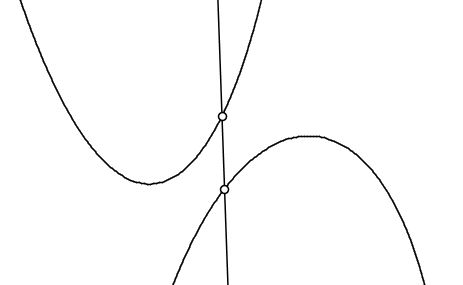Fenchel's duality theorem
In mathematics, Fenchel's duality theorem is a result in the theory of convex functions named after Werner Fenchel.
Let ƒ be a proper convex function on Rn and let g be a proper concave function on Rn. Then, if regularity conditions are satisfied,
where ƒ * is the convex conjugate of ƒ (also referred to as the Fenchel–Legendre transform) and g * is the concave conjugate of g. That is,
Mathematical theorem
Let X and Y be Banach spaces,  and
and  be convex functions and
be convex functions and  be a bounded linear map. Then the Fenchel problems:
be a bounded linear map. Then the Fenchel problems:
satisfy weak duality, i.e.  . Note that
. Note that  are the convex conjugates of f,g respectively, and
are the convex conjugates of f,g respectively, and  is the adjoint operator. The perturbation function for this dual problem is given by
is the adjoint operator. The perturbation function for this dual problem is given by  .
.
Suppose that f,g, and A satisfy either
- f and g are lower semi-continuous and
 where
where  is the algebraic interior and
is the algebraic interior and  where h is some function is the set
where h is some function is the set  , or
, or -
 where
where  are the points where the function is continuous.
are the points where the function is continuous.
Then strong duality holds, i.e.  . If
. If  then supremum is attained.[1]
then supremum is attained.[1]
One-dimensional illustration
In the following figure, the minimization problem on the left side of the equation is illustrated. One seeks to vary x such that the vertical distance between the convex and concave curves at x is as small as possible. The position of the vertical line in the figure is the (approximate) optimum.

The next figure illustrates the maximization problem on the right hand side of the above equation. Tangents are drawn to each of the two curves such that both tangents have the same slope p. The problem is to adjust p in such a way that the two tangents are as far away from each other as possible (more precisely, such that the point where they intersect the y-axis are as far from each other as possible). Imagine the two tangents as metal bars with vertical springs between them that push them apart and against the two parabolas that are fixed in place.

Fenchel's theorem states that the two problems have the same solution. The points having the minimum vertical separation are also the tangency points for the maximally separated parallel tangents.
See also
References
- Rockafellar, Ralph Tyrrell (1996). Convex Analysis. Princeton University Press. ISBN 0-691-01586-4. See page 327.




